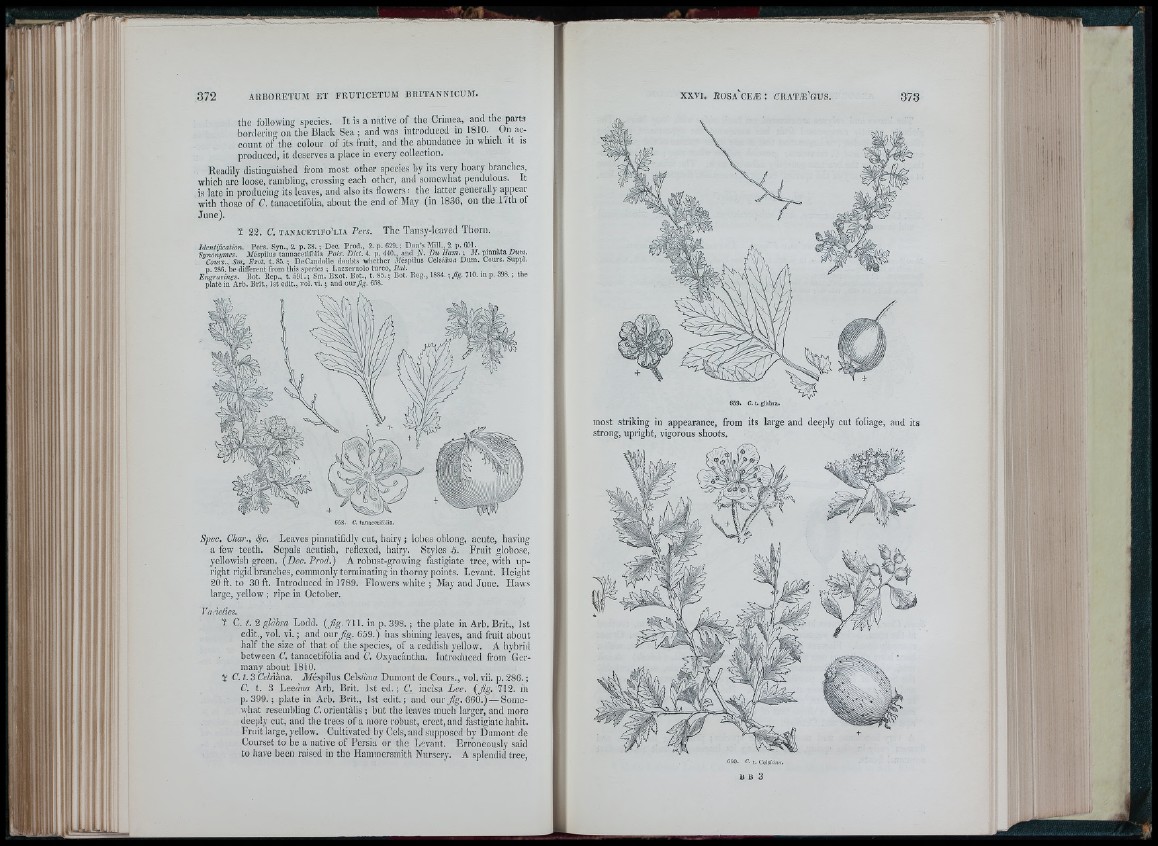
the following species. It is a native of the Crimea, and the parts
bordering on the Black Sea ; and was introduced in 1810. On account
of the colour of its fruit, and the abundance in which it is
produced, it deserves a place in every collection.
Readily distinguished from most other species by its very hoary branches,
which are loose, rambling, crossing each other, and somewhat {lendulous. It
is late in producing its leaves, and also its flowers : the latter generally appear
with those of C. tanacetifòlia, about the end of May (in 1836, on the 17th of
June).
t 2-2. C. t a n a c e t i f o ' l i a P c t s . The Tansy-leaved Thorn.
Identification. Pers. Syn., 2. p. 38. ; Dec. P rod., 2. p. 629. ; Do n ’s Mill., 2. p. G91. ,
Synonymes. Méspilus tannacetifùlia Poir. Diet. 4. p. 440., and N . Du H am .; M. ninnata D«r/t.
Cours., Sin, Exot. t. 85. ; DeCandolle doubts whether Mespilus Cels/ójw Dum. Cours. Suppl.
p. 286. he different from this species ; Lazzcruolo turco, Hal.
Engravings. Bot. Rep., t. 591.; Sm. E x o t. Bot., t. 85. ; Bot. Reg., 18S4. ; jig. 710. in p. 398. ; the
plate in Arb. Brit., 1st edit., vol. vi. ; and our Jig. 6.58.
658. C. tanacetifòlia.
Spec. Char., Leaves pinnatifidly cut, hairy ; lobes oblong, acute, having
a few teeth. Sepals acutish, reflexed, hairy. Styles 5. F ruit globose,
yellowish green. {Dec. Prod.) A robust-growing fastigiate tree, with upright
rigid branches, commonly terminating in thorny points. Levant. Iieight
20 ft. to 30 ft. Introduced in 1789. Flowers white ; May and June. Haws
large, yellow ; ripe in October.
Varieties.
H C. A 2 glàbra Lodd. {fig, 711. in p. 398. ; the plate in Arb. Brit., 1st
edit., vol. vi. ; and o u r^ g . 659.) has shining leaves, and fruit about
half the size of that of the species, of a reddish yellow. A hybrid
between C. tanacetifòlia and C. Oxyacantha. Introduced from Germany
about 1810.
'¡t C .t.3 tc/riana. ATespilus Cels«)«a Dumont de Cours., vol. vii. p. 286. ;
C. t. 3 Leerka Arb. Brit. 1st ed. ; C. incìsa Lee. (fig . 712. in
p. 399. ; plate in Arb. Brit., 1st edit.; and our j%. 660.)— Somewhat
resembling 0. orientàlis ; but the leaves much larger, and more
dee|)ly cut, and the trees of a more robust, erect, and fiistigiate habit.
Fi-iiit large, yellow. Cultivated by Cels, and supposed by Dumont dc
Courset to be a native of Persia or the Levant. Erroneously said
to have been raised in the Hammersmith Nursery. A splendid tree.
669. C. t. glàbra.
most striking in appearance, from its large and deeply cut foliage, and its
strong, upright, vigorous shoots.
CCO. c. f. Celstrf/I«.
B B 3
i i!
"J ■ !■
lì ' : .1
if :
f f :